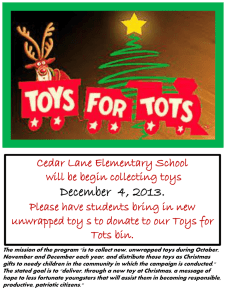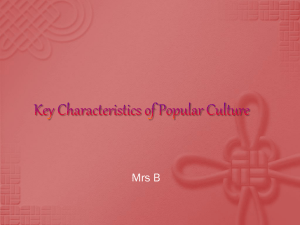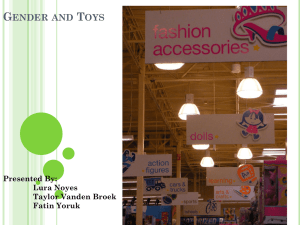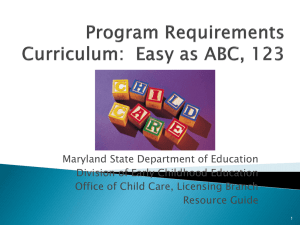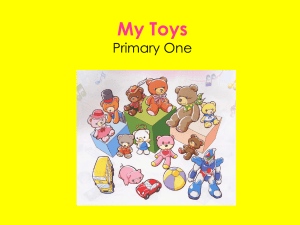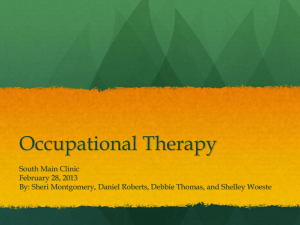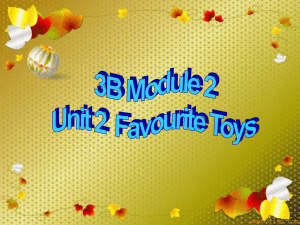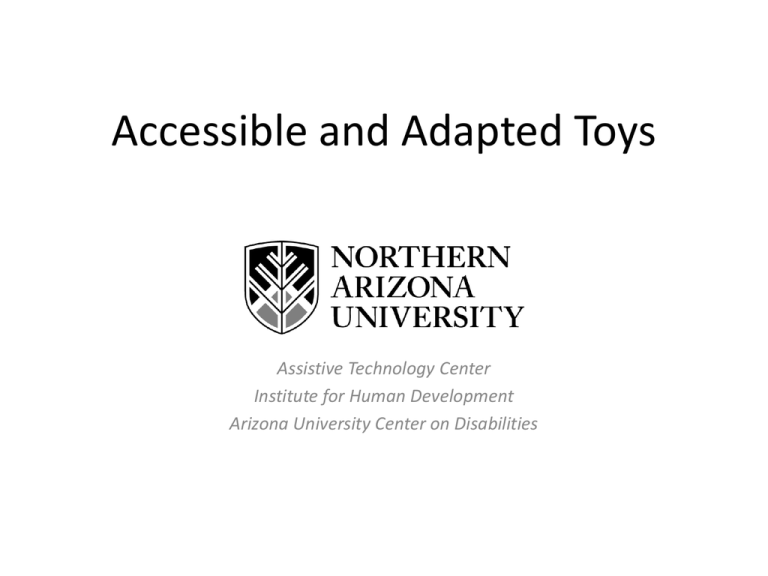
Accessible and Adapted Toys
Assistive Technology Center
Institute for Human Development
Arizona University Center on Disabilities
Who Are We?
• Northern Arizona University’s Institute for
Human Development Assistive Technology
Center
– Lesley Iacona M.Ed., CCC-SLP
– Nikki Anderson MA, OTR/L, ATP
What is Play?
“Play is the work of the child.” – Maria Montessori
“Play is a child’s work.” – Jean Piaget
“Play is the highest form of research.” -Albert Einstein
Importance of Play
Play helps children develop social, emotional, physical, language and creative skills.
The Benefits of Play
• Vocabulary/language development
• Problem solving
• Imagination
• Abstract thinking
• Empathy, perspective-taking
• Learning new concepts
• Turn taking skills
• Attention regulation
• Concentration
• Persistence
• Sharing/Cooperation
• Expressing feelings
• Social skills
• Repetition
Importance of Play
• Click Here to read a short article that
describes the basic skills developed through
play in more detail. This article also includes
excellent references if you are interested in
learning more about the importance of play
for young children.
Biological Value of Play
Click Here to watch an interesting TED Talk given
by Dr. Stuart Brown from the National Institute
for Play. Dr. Brown discusses how play is more
than just fun for both children and adults.
• Play deprivation results in abnormal brain
development.
• Play is not just practice for adult skills. Play
holds biological value in and of itself, similar to
sleep and dreams.
During Play
• Children
– Watch
– Listen
– Explore
– Imitate
– Create and Use Language for a Purpose
Barriers to Play
• Skill Barriers
– Mobility Impairments - Difficulty handling toys
– Vision Impairments - Difficulty discerning
color/pattern characteristics
– Hearing Impairments - Misses feedback from toys
– Fine Motor Impairments - Difficulty manipulating toys
– Knowledge of “how” to play - Has limited experience
with play
– Speech-Language Impairments - Difficulty creating
scripts for play or communicating requests and
demands during play.
Barriers to Play
• Environmental Barriers
– Inaccessible environments - Child can’t get to toys
– Lack of supports - Caregiver has limited time for
assistance
Barriers to Play
• Age-labels - Baby toys may have some of the
desired characteristics for older children, but
are not age appropriate.
• Children and families may view using
“different” toys as socially unacceptable.
Universal Design for Play
• The concept of universal design as it applies to
toys is to design play items that are inherently
accessible and motivating to children of all
abilities.
Why Start with Universal Design Toys?
– Many families express that they prefer off-theshelf toys over specialized toys
– Look and function like toys all children use
– Often more durable
– Can use for all children in the family
– Often less costly option than purchasing
specialized toys
Universal Design for Play
• The University at Buffalo’s Assistive
Technology Center has federal funding to
research and disseminate information related
to universal design for play. Their project is
called Let’s Play! And can be found by Clicking
Here.
Examples of UD Toy Companies
The mainstream toy company Melissa &
Doug produce popular items with universal
design features. Many of their products
provide large surfaces for a better grip,
added sound for auditory feedback, and
brightly colored materials to draw visual
attention to the item.
Playworks is a company
marketing toys using
universal design. They
categorize their toys by
features or targeted skills.
Development by Design is a company that is
currently defunct but still sells its products
through The Pencil Grip.
What to Look For
The Universal Design for Play Tool (Ruffino & Mistrett, 2006) designed by staff
at the University of Buffalo’s Let’s Play project can help parents and support
staff select toys for children with and without disabilities. This tool lists the
following features as contributing most to the enjoyment of all children.
• The toy is appealing
– Multiple colors, textures, dimensions, scents, and/or sounds.
• How to play with the toy is clear.
• The toy is easy to use.
– Easy to pickup, hold, and use by children with a range of abilities.
Ruffino, A.G., & Mistrett, S.G. (2006). The universal design for play tool: Establishing validity and
reliability. Journal of Special Education Technology 21(4), 25-35.
What to Look For
•
The toy is adjustable.
– A variety of actions can be used. The toy allows the child to play in different
positions. The height, volume, level of difficulty, and/or speed can be adjusted.
•
The toy promotes development.
– Encourages imagination, social play, discovery of new ways to play, and physical or
cognitive activity.
•
The toy can be played with in different ways.
– Appropriate for different ages and levels. Can be used differently for different types
of play.
Ruffino, A.G., & Mistrett, S.G. (2006). The universal design for play tool: Establishing validity
and reliability. Journal of Special Education Technology 21(4), 25-35.
Examples of UD Toys
What UD features do these toys have?
Shape, Model, and Mold Play Clay
Happy Handle Stamp Set
Chunky Farm Puzzle
Large Knob Shape Puzzle
What UD features do
these toys have?
Musical Instruments Sound Puzzle
What features of UD does
this toy have?
Scratch Art Portable Light Box
What UD features
does this toy have?
What UD features does
this toy have?
Textured Stencils
Adapted Toys
• If you cannot find a toy with the universal
design features you need, you can purchase or
construct your own adapted toys.
What to Look For
•
Multisensory appeal (lights, sounds, movement, contrasting colors, scent,
texture?)
•
Appropriate method of activation
•
Where toy will be used (easy to store, space in the home, used in a variety of
positions?)
•
Opportunities for success (open ended with no definite right or wrong way to
play)
•
Current popularity (does it make the child feel like “any other kid”?)
National Lekotek Center. (2003). National Lekotek center’s top ten tips to consider when
buying toys for children with disabilities.
What to Look For
• Self-expression (does it allow for creativity, uniqueness, and
choice making?)
• Adjustability (adjustable height, sound, speed, level of difficulty?)
• Child’s individual characteristics (provides activities that reflect the child’s
interests to match their age both developmental and chronologically?)
• Safety and durability (matches the child’s strength and size, moisture
resistance, parts sized appropriately, washing and cleaning)
• Potential for interaction (Can the child be an active participant? Will it
encourage social engagement?)
National Lekotek Center. (2003). National Lekotek center’s top ten tips to consider when
buying toys for children with disabilities.
Adaptive Toy Companies
There are many companies that sell adaptive toys.
•
•
•
•
•
•
•
•
Achievement Products
Beyond Play
Dragon Fly Toy Company
Enabling Devices
Flaghouse- Special Populations
Funtastic Therapy Catalog
Jesana, Ltd
Kapable Kids, Inc.
•
•
•
•
Sportime Abilitations
Technical Solutions- Australia
TFH (USA)Ltd.
Therapy Toy Shop
Let’s Play! (2013) Retrieved from
http://letsplay.buffalo.edu/play/Play%20vendors%20special-%20urls.pdf.
Examples of Adaptive Toys
Switch Adapted Magical Light Show
Switch Adapted Toys
Examples of Adaptive Toys
Vibrating Mini Rib-It Ball
VibroLadyBug
Examples of Adapted Toys
• Examples from the AT Center to pass around.
Ablenet Inc.
• YouTube video on switch adapted toys:
– http://www.youtube.com/watch?v=x0CVVnw2s94
• Regular use of switches
• Switch-latch and timer use
• Wireless access to toys
Switch Adapting Your Own Toys:
Using Battery Interrupters
– Battery Interrupters are easiest way to switch
adapt simple toys.
– View this 3 part video on using premade battery
interrupters:
• http://enablingdevices.com/catalog/usefuldevices/battery_interrupters/battery-interrupters
Battery Interrupters
– Companies that sell battery interrupters
• Adaptivation $12
• Enabling Devices $10 - $15
• Ablenet Inc. $13
– How to make your own battery interrupters:
• http://www.smasupport.com/making_a_switchadapte
d_toy.htm
Switch Adapting Your Own Toys:
Hardwiring
• If you have a more complicated toy, you can adapt
some toys for switches. There are many videos online
that step you through this process.
• YouTube videos on how to adapt switch toys:
– http://www.youtube.com/watch?v=pD944_I7sis
– http://www.smasupport.com/hardwiring-toys.htm
– http://www.glenallensch.vic.edu.au/instructions/adapting-simple-switchtoys.pdf
– http://inclusiveconnections.com/Adapting_Toys.html
For Gamers
• For adaptive gamers:
– http://www.theadaptivegamer.com/
– http://www.gimpgear.us/gaming
• For adapting your own controllers:
– http://www.oneswitch.org.uk/4/DIY/index.htm
• Adaptive Wii Kit:
– http://www.broadenedhorizons.com/switch-enablednintendo-wii-remote-kit
Using AAC devices
• You can use high-tech AAC devices with infrared
environmental control features to control infrared toys. The
following companies have instructions on their website that
guide you through the process.
•
DynaVox:
http://www.dynavoxtech.com/support/kb/details/?id=3775
•
Prenke Romich Company:
http://www.prentrom.com/support/article/1105
•
Tobii: http://www.tobii.com/en/assistivetechnology/global/support-anddownloads/faqs/50130000000Sqze/
Using AAC devices for IR Toys
Toys “R” Us Infrared Toys
Dinosaur and Gorilla are controlled by infrared technology.
This allows AAC devices with environmental control features
to be programmed to control these toys.
Adapting Books
• Interactive Books
• Adding Icons to Books
Photos are from http://littlemisskimberlyann.blogspot.com/2013/09/tips-for-adapting-books-for-kids-with.html
Adapted Books
• Texture Books
• Baggie Books
www.med.unc.edu/ahs/clds/files/early-childhood-resources/therm.funbooksfo.pdf
www.pathstoliteracy.org
Adapted Books
• Page Turners
• Talking Books such as Tarheel Reader
• Powerpoint Books
Adapting Books
The document A-Z of Adapting Books for Students
with Disabilities in Virginia can be found at:
http://www.vcu.edu/ttac/images/Handout_for_AZ_of_Adapting_Books_for_Students_with_Disabilities
_in_Virginia.pdf. It contains an abundance of
information about how to create play materials
focused on increasing literacy opportunities using
adapted books for students with disabilities.
GoBabyGo!
• Dr. Cole Galloway at the University of Delaware
– Modifies “off-the-shelf toy racecars to provide mobility to
children with crawling and walking problems, empowering
them to be part of the action at home, in the daycare
center, and on the playground.”
– http://www.udel.edu/gobabygo/
– Hosts “make and take” clinics and trainings.
– Conducts research on the impact of power mobility on
early skill development.
Our GoBabyGo TowMater Vehicle
Our GoBabyGo Tinkerbelle Stand Up
Vehicle
One final important
note……..remember
that play may be a
child’s “work”, but it
should be inherently
FUN!
NAU AT Center Loan Equipment
• We have a library of adapted toys that can be loaned to
families and individuals with disabilities. See our
inventory by stopping in the AT Center or checking out
and liking our page on Facebook!
• Facebook Page Name: NAU Assistive Technology Center
• Northern Arizona University’s Institute for Human
Development Assistive Technology Center at
http://nau.edu/SBS/IHD/Community-Resources/
Other Local Resources for
Adaptive Toys
• Arizona Technology Access Project (AZTAP) at
aztap.org
• Arizona Department of Education Loan Library at
http://nau.edu/SBS/IHD/Programs/ADE-AssistiveTechnology-Loan-Library/

